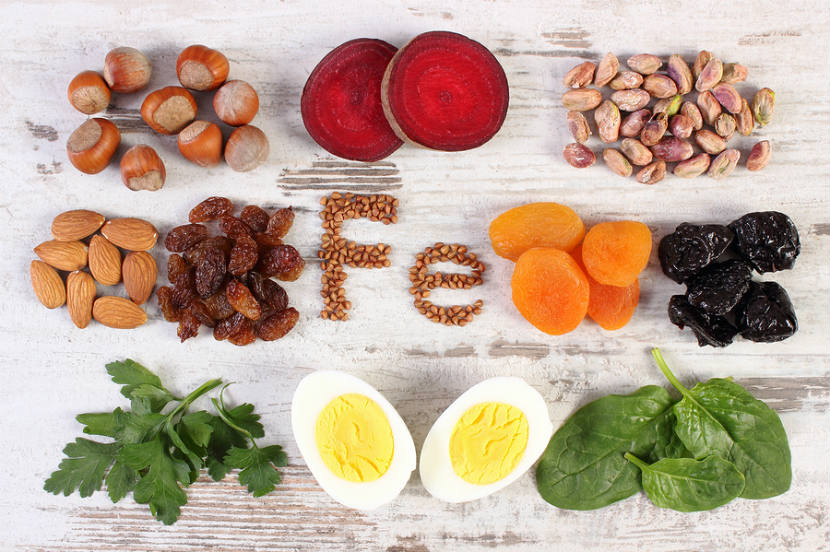
Iron is a mineral that is important for good health. Your body needs it to make blood cells that carry oxygen to all the parts of your body. Iron is also needed for growth, development and to make specific hormones. Read on to learn what foods have iron and how to get enough.
How much iron do I need?
The amount of iron you need depends on your age and gender. Vegetarians need to eat twice as much iron as non-vegetarians because the iron in plant foods it not absorbed as well by your body. Find out how much you need here.
What foods have iron?
Iron is found in a variety of animal foods, plant foods and iron fortified products (like breads, pastas and cereals). There are two types of iron – heme and non-heme. Heme iron is found in animal foods. Non-heme iron is found in plant foods. Heme iron is better absorbed in the body than non-heme iron.
Sources of heme iron (animal foods)
|
Food |
|
Examples |
|
|
Meat |
|
Beef, pork, poultry, lamb, duck, venison |
|
|
Organ meat |
|
Liver, kidney |
|
|
Seafood |
|
Oysters, shrimp, octopus, clams, scallops, crab |
|
|
Fish |
|
Mackerel, trout, bass, tuna, sardines |
|
|
Eggs |
|
Chicken, duck, quail |
|
Sources of non-heme iron (plant foods)
|
Food |
|
Examples |
|
|
Tofu |
|
Extra firm has more iron than soft, medium or firm |
|
|
Legumes |
|
Red, green, brown lentils, black-eyed peas, split peas, chickpeas, soybeans, black beans, white beans, pinto beans, kidney beans |
|
|
Nuts and nut butters |
|
Almonds, cashews, hazelnuts, pistachios, soy nuts |
|
|
Seeds and seed butters |
|
Pumpkin seeds, sunflower seeds, sesame seeds |
|
|
Grain products |
|
Enriched cold cereals, pasta, instant oatmeal, oat bran cereal, cream of wheat |
|
|
Soy products |
|
Fortified soy beverage, soy yogurt, tempeh |
|
|
Vegetables |
|
Cooked spinach, asparagus, beets, beet greens, turnip greens |
|
|
Other |
|
Blackstrap molasses, yeast extract spread (marmite, vegemite) |
|
Tips to get enough iron:
-
Eat a variety of foods that contain heme iron and non-heme iron each day.
-
Increase the absorption of non-heme iron in foods by eating them with heme iron foods (like meat, fish or poultry) or foods that contain vitamin C.
-
Vitamin C increases the absorption of non-heme iron. Combine foods that contain non-heme iron with foods that have vitamin C. For example, serve hummus (source of iron) with red bell pepper slices (source of vitamin C).
Tips for adding iron to meals and snacks
Breakfast
-
Drink a glass of orange or grapefruit juice with beans and toast.
-
Add dried apricots to your favourite trail mix.
-
Include red or green bell peppers or asparagus in an omelette.
-
Enjoy hot or cold cereal with orange segments, strawberry slices or kiwi.
-
Make a smoothie with fortified soy beverage and frozen mango or frozen strawberries.
-
Top whole-grain toast with almond butter and sliced strawberries.
Lunch
-
Enjoy a chicken or beef stir fry on top of whole grain rice or quinoa.
-
Add legumes (like lentils, chickpeas, black beans, pinto beans, kidney beans) to your favourite beef-chili recipe.
-
Add red or green bell pepper, broccoli, cauliflower and snow peas to a tofu stir-fry.
-
Add split peas to a fish chowder.
-
Make mango chicken wraps or beef and rice kebabs.
-
Add almonds or pumpkin seeds to a spinach salad. Garnish with orange and grapefruit segments or sliced strawberries.
-
Serve hummus or black bean dip with broccoli, cauliflower, and red and green bell peppers.
Dinner
-
Prepare a potato, cauliflower, lentil curry and serve it over rice.
-
Have enriched pasta with meat and tomato sauce.
-
Make a vegetarian tomato sauce with extra firm tofu and pureed tomatoes.
-
Enjoy a shrimp and vegetable dish.
-
Add red or yellow lentils to a chicken casserole.
-
Add pinto beans and black beans to chicken quesadillas or beef enchiladas.
-
Serve steamed trout with a lemon wedge.
-
Have roasted Brussels sprouts as a side to pork tenderloin.
Vegetarian options for iron
-
Make a vegetarian chili with kidney beans, chickpeas, black beans and tomatoes.
-
Have whole grain toast with almond butter or soy butter.
-
Prepare a red lentil curry served with cooked spinach over brown rice.
You can meet all of your iron needs even without animal foods. Read more about meeting your iron needs if you are vegetarian or vegan.
How do I read the food label for iron?
When shopping for packaged products, look for:
-
"Iron” or “ferrous” in the ingredient list. This means that iron has been added to the product.
-
Products that contain more than 15% DV (Percent Daily Value) for iron. This is listed in the Nutrition Facts table.
Find out more about reading the nutrition label.
What if I don’t get enough iron?
If you think you are not getting enough iron from food, speak with your health care provider or dietitian. They will tell you if you need an iron supplement and recommend the type and amount of iron that’s best for you.
Bottom line
Iron is important for your health. Choose iron rich foods from plant and animal sources. Use nutrition labels to help you choose iron-rich foods. If you think you may not be getting enough iron, speak with your health care provider or dietitian.
You may also be interested in
What you need to know about iron
Managing iron deficiency
Last Update – September 8, 2019